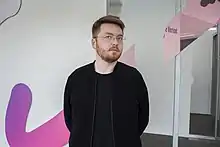Artie Vierkant
Artie Vierkant (born 1986)[1] is an American digital artist based in Brooklyn, New York, known for his "Image Objects" series. The series is based on the 2010 essay "The Image Object Post-Internet", which he wrote while in graduate school.[2] The series began in 2011 and, as of 2019, is still ongoing.[3] Each work in the series is first created by Vierkant as a digital file on a computer, which he then UV prints out and fits onto a three-dimensional sculpture. As Emily Dubovoy noted in a 2012 Vice article about the series, "...there’s more to it than just the physical objects that one would view in a gallery. The series has another portion to it that lives in, you guessed it, the internet."[4] In 2013, Vierkant began a series called "Exploits", in which he attempts to stretch the limits of what works of art violate intellectual property laws.[5] In 2018, he released a virtual reality app based on the Image Objects series to coincide with the debut of his exhibition "Rooms greet people by name" at Galerie Perrotin, a European art gallery with its Manhattan branch on the Lower East Side.[6] In a 2018 article in Garage, Paddy Johnson wrote that Vierkant's "...work is distinct from that of colleagues such as Petra Cortright, Michael Staniak, and Michael Manning, all of whom take a more intuitive approach. By contrast, Vierkant is the classic conceptualist, fixated on the distinction between the object and its documentation, and theorizing — in classic Baudrillardian fashion — that representation can exist without reference to an original."[7] Vierkant is also the co-host of the podcast Death Panel,[8] and the co-author (with Beatrice Adler-Bolton) of Health Communism, which was published by Verso Books in October 2022.[9]
Artie Vierkant | |
|---|---|
 Vierkant in 2017 | |
| Born | Arthur Benjamin Vierkant 1986 (age 36–37) |
| Education | University of Pennsylvania (BA, 2009) University of California, San Diego (MFA, 2011) |
| Notable work | Image Objects |
| Website | artievierkant |
References
- "Paul Brach Lecture Series". Calarts. November 9, 2017. Retrieved November 21, 2021.
- Small, Rachel (September 1, 2015). "Artists at Work: Artie Vierkant". Interview Magazine. Retrieved November 21, 2021.
- America, Art in (December 20, 2019). "An Art World Glossary for a Turbulent Decade". ARTnews.com. Retrieved November 21, 2021.
- Dubovoy, Emily (November 20, 2012). "Real-Life Digital Sculptures Are More Than They Appear". Vice. Retrieved November 21, 2021.
- Greenberger, Alex (October 13, 2015). "'I Don't Buy Into the Idea of the Grand Artist Mythos': Artie Vierkant on His Shows at Feuer/Mesler and Mesler/Feuer". ARTnews.com. Retrieved November 21, 2021.
- Zeiba, Drew (March 13, 2018). "Artist Artie Vierkant uses augmented reality to put his art in your hands". The Architect’s Newspaper. Retrieved November 22, 2021.
- Johnson, Paddy (March 13, 2018). "This Is Why Post-Internet Art Doesn't Look Hi-Tech". Garage. Retrieved November 21, 2021.
- Chayka, Kyle (April 13, 2021). "In the New Digital Economy, Are Artists Creators?". ARTnews.com. Retrieved November 21, 2021.
- "Health Communism by Beatrice Adler-Bolton, Artie Vierkant: 9781839765162 | PenguinRandomHouse.com: Books". PenguinRandomhouse.com. Retrieved April 28, 2022.